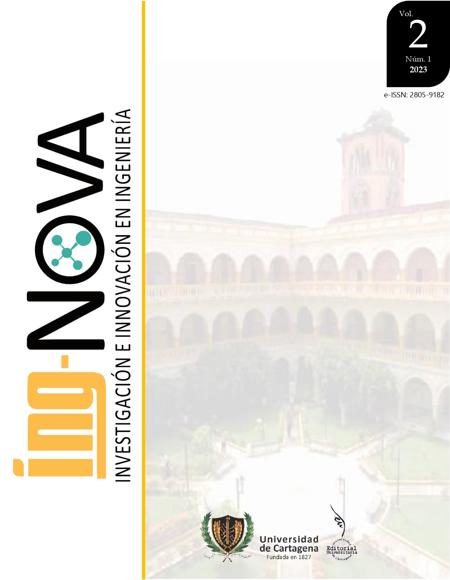Herramientas digitales usadas para la innovación e investigación en la ingeniería: Interpretación individual del fenómeno de la transformación digital del recurso humano
Digital tools used for innovation and research in engineering: individual interpretation of the phenomenon of digital transformation of human resources
Contenido principal del artículo
Resumen
Palabras clave
Descargas
Datos de publicación
Perfil evaluadores/as N/D
Declaraciones de autoría
Indexado en
- Sociedad académica
- Universidad de Cartagena
- Editorial
- Universidad de Cartagena
Detalles del artículo
Referencias (VER)
A. Bansal, T. Panchal, F. Jabeen, S. K. Mangla, and G. Singh, “A study of human resource digital transformation (HRDT): A phenomenon of innovation capability led by digital and individual factors,” J. Bus. Res., vol. 157, no. December 2022, p. 113611, Mar. 2023. DOI: https://doi.org/10.1016/j.jbusres.2022.113611
N. F. Crespo, C. F. Crespo, G. M. Silva, and M. B. Nicola, “Innovation in times of crisis: The relevance of digitalization and early internationalization strategies,” Technol. Forecast. Soc. Change, vol. 188, no. June 2022, p. 122283, Mar. 2023. DOI: https://doi.org/10.1016/j.techfore.2022.122283
M. Srivani, A. Murugappan, and T. Mala, “Cognitive computing technological trends and future research directions in healthcare — A systematic literature review,” Artif. Intell. Med., vol. 138, no. February 2022, p. 102513, 2023. DOI: https://doi.org/10.1016/j.artmed.2023.102513
E. Zarei, F. Khan, and R. Abbassi, “How to account artificial intelligence in human factor analysis of complex systems?,” Process Saf. Environ. Prot., vol. 171, no. October 2022, pp. 736–750, 2023. DOI: https://doi.org/10.1016/j.psep.2023.01.067
J. Kim, M. McFee, Q. Fang, O. Abdin, and P. M. Kim, “Computational and artificial intelligence-based methods for antibody development,” Trends Pharmacol. Sci., vol. 44, no. 3, pp. 175–189, 2023. DOI: https://doi.org/10.1016/j.tips.2022.12.005
E. Camacho, “Aplicación de Minería de Datos en el Proceso de Toma de Decisiones de Proyectos Energéticos en Zonas no Interconectadas en Colombia,” J. Chem. Inf. Model., vol. 53, no. 9, pp. 1689–1699, 2020.
E. J. F. Dickinson, H. Ekström, and E. Fontes, “COMSOL Multiphysics®: Finite element software for electrochemical analysis. A mini-review,” Electrochem. commun., vol. 40, pp. 71–74, 2014. DOI: https://doi.org/10.1016/j.elecom.2013.12.020
E. Davidson, L. Wessel, J. S. Winter, and S. Winter, “Future directions for scholarship on data governance, digital innovation, and grand challenges,” Inf. Organ., vol. 33, no. 1, p. 100454, Mar. 2023. DOI: https://doi.org/10.1016/j.infoandorg.2023.100454
D. S. N. Abg Shamsuddin et al., “Computational fluid dynamics modelling approaches of gas explosion in the chemical process industry: A review,” Process Saf. Environ. Prot., vol. 170, no. June 2022, pp. 112–138, 2023. DOI: https://doi.org/10.1016/j.psep.2022.11.090
A. Hadane, L. Khamar, S. Benjelloun, and A. Nounah, “Hydrodynamic study of a phosphate flotation cell by CFD approach,” Chem. Eng. Process. - Process Intensif., vol. 135, no. September 2018, pp. 190–203, 2019. DOI: https://doi.org/10.1016/j.cep.2018.11.012
Z. Zhang and Q. Chen, “Comparison of the Eulerian and Lagrangian methods for predicting particle transport in enclosed spaces,” Atmos. Environ., vol. 41, no. 25, pp. 5236–5248, 2007. DOI: https://doi.org/10.1016/j.atmosenv.2006.05.086
D. Dubbeldam, J. Vreede, T. J. Vlugt, and S. Calero, “Highlights of (bio-)chemical tools and visualization software for computational science,” Curr. Opin. Chem. Eng., vol. 23, pp. 1–13, 2019. DOI: https://doi.org/10.1016/j.coche.2019.02.001
C. C. (CC), “Paso a paso en el modelado multifísico con COMSOL Multiphysics © Copyright 1994 - 2021. Addlink Software Científico, S.L.,” 1994 - 2021. [Online]. Available: https://www.addlink.es/noticias/comsol/2739-paso-a-paso-en-el-modelado-multifisico-con-comsol-multiphysics.
S. Li, L. Gao, C. Han, B. Gupta, W. Alhalabi, and S. Almakdi, “Exploring the effect of digital transformation on Firms’ innovation performance,” J. Innov. Knowl., vol. 8, no. 1, p. 100317, Jan. 2023. DOI: https://doi.org/10.1016/j.jik.2023.100317
E. Jakku, A. Fleming, M. Espig, S. Fielke, S. C. Finlay-Smits, and J. A. Turner, “Disruption disrupted? Reflecting on the relationship between responsible innovation and digital agriculture research and development at multiple levels in Australia and Aotearoa New Zealand,” Agric. Syst., vol. 204, no. February 2022, p. 103555, Jan. 2023. DOI: https://doi.org/10.1016/j.agsy.2022.103555
W. Li and W. Pang, “Digital inclusive finance, financial mismatch and the innovation capacity of small and medium-sized enterprises: Evidence from Chinese listed companies,” Heliyon, vol. 9, no. 2, p. e13792, Feb. 2023. DOI: https://doi.org/10.1016/j.heliyon.2023.e13792
A. G. Olabi et al., “Application of artificial intelligence for prediction , optimization , and control of thermal energy storage systems,” Therm. Sci. Eng. Prog., vol. 39, no. January, p. 101730, 2023. DOI: https://doi.org/10.1016/j.tsep.2023.101730
P. Chen and S. Kim, “The impact of digital transformation on innovation performance - The mediating role of innovation factors,” Heliyon, vol. 9, no. 3, p. e13916, Mar. 2023. DOI: https://doi.org/10.1016/j.heliyon.2023.e13916
M. Q. Tran, H. P. Doan, V. Q. Vu, and L. T. Vu, “Machine learning and IoT-based approach for tool condition monitoring: A review and future prospects,” Meas. J. Int. Meas. Confed., vol. 207, no. June 2022, p. 112351, 2023. DOI: https://doi.org/10.1016/j.measurement.2022.112351
B. Awatey, H. Thanasekaran, J. N. Kohmuench, W. Skinner, and M. Zanin, “Optimization of operating parameters for coarse sphalerite flotation in the HydroFloat fluidised-bed separator,” Miner. Eng., vol. 50–51, pp. 99–105, 2013. DOI: https://doi.org/10.1016/j.mineng.2013.06.015



 PDF
PDF
 FLIP
FLIP






